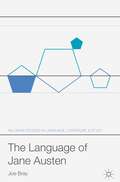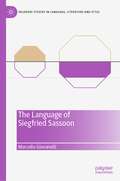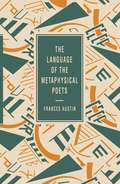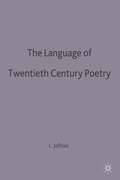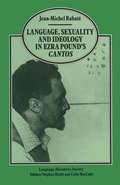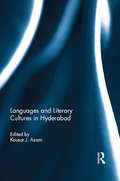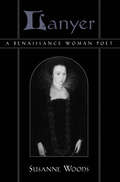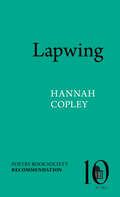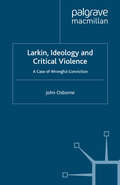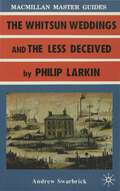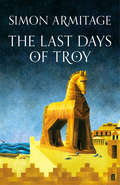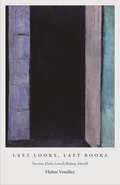- Table View
- List View
The Language of Contemporary Poetry: A Framework for Poetic Analysis (Palgrave Studies in Language, Literature and Style)
by Lesley JeffriesThis book introduces a new way of looking at how poems mean, drawing on the framework first developed in the author’s book Critical Stylistics, but applied here to aesthetic more than ideological meaning. The aim is to empower readers of poetry to articulate the features of poetic language that they come across and explain to themselves and others why these features convey the meanings that they do. While this volume focuses on contemporary poets writing in English and mostly based in the UK and Ireland, the framework will work just as well for other eras’ poetry, as well as for other cultures and languages.
The Language of Dystopia (Palgrave Studies in Language, Literature and Style)
by Jessica NorledgeThis book presents an extended account of the language of dystopia, exploring the creativity and style of dystopian narratives and mapping the development of the genre from its early origins through to contemporary practice. Drawing upon stylistic, cognitive-poetic and narratological approaches, the work proposes a stylistic profile of dystopia, arguing for a reader-led discussion of genre that takes into account reader subjectivity and personal conceptualisations of prototypicality. In examining and identifying those aspects of language that characterise dystopian narratives and the experience of reading dystopian fictions, the work discusses in particular the manipulation and construction of dystopian languages, the conceptualisation of dystopian worlds, the reading of dystopian minds, the projection of dystopian ethics, the unreliability of dystopian refraction, and the evolution and hybridity of the dystopian genre.
The Language of French Symbolism
by James R. LawlerThe traits that characterize the "language" of French Symbolism are the center of these essays. In interpreting major or previously neglected compositions by Mallarmé, Verlaine, Rimbaud, Claudel, Valéry, and Apollinaire, the author shows how each of these poets worked with the elements that distinguish this influential group of writers as a whole.Originally published in 1969.The Princeton Legacy Library uses the latest print-on-demand technology to again make available previously out-of-print books from the distinguished backlist of Princeton University Press. These editions preserve the original texts of these important books while presenting them in durable paperback and hardcover editions. The goal of the Princeton Legacy Library is to vastly increase access to the rich scholarly heritage found in the thousands of books published by Princeton University Press since its founding in 1905.
The Language of Jane Austen (Language, Style and Literature)
by Joe BrayJoe Bray’s careful analysis of Jane Austen’s stylistic techniques reveals that the genius of her writing is far from effortless; rather he makes the case for her as a meticulous craftswoman and a radical stylistic pioneer. Countering those who have detected in her novels a dominant, authoritative perspective, Bray begins by highlighting the complex, ever-shifting and ambiguous nature of the point of view through which her narratives are presented. This argument is then advanced through an exploration of the subtle representation of speech, thought and writing in Austen’s novels. Subsequent chapters investigate and challenge the common critical associations of Austen’s style with moral prescriptivism, ideas of balance and harmony, and literal as opposed to figurative expression. The book demonstrates that the wit and humour of her fiction is derived instead from a complex and subtle interplay between different styles. This compelling reassessment of Austen’s language will offer a valuable resource for students and scholars of stylistics, English literature and language and linguistics.
The Language of Siegfried Sassoon (Palgrave Studies in Language, Literature and Style)
by Marcello GiovanelliThis book presents a cognitive stylistic analysis of the writing of Siegfried Sassoon, a First World War poet who has typically been perceived as a poet of protest and irony, but whose work is in fact multi-faceted and complex in theme and shifted in style considerably throughout his lifetime. The author starts from the premise that a more systematic account of Sassoon’s style is possible using the methodology of contemporary stylistics, in particular Cognitive Grammar. Using this as a starting point, he revisits common ideas from Sassoon scholarship and reconfigures them through the lens of cognitive stylistics to provide a fresh perspective on Sassoon's style. This book will be of interest to students and scholars of stylistics, war poetry, twentieth-century literature, and cognitive linguistics.
The Language of the Metaphysical Poets
by Frances AustinIn this volume, Dr Frances Austin examines the language of the five best-known metaphysical poets, Donne, Herbert, Crashaw, Vaughan and Traherne. She shows how the characteristics of their vocabulary, figurative language, syntactical structures and versification reflect their individual attitudes to their shared Christian faith, which is the subject matter of most of their poetry. The diversity of language, albeit having a common basis, is demonstrated in the course of this study.
The Language of Twentieth Century Poetry
by Lesley HeffriesThis book draws on examples from throughout the twentieth century to illustrate the diversity of techniques used in this century's poetry. Organised according to linguistic themes, rather than chronologically, the chapters introduce the reader to the more subtle uses of sound, structure and meaning as well as illustrating well-known techniques handed-down from the poetic tradition. Examples are taken from the famous writers of the twentieth century, such as Yeats, Eliot and Plath and from less well-known poets. The book culminates in a chapter which draws together the linguistic themes into an integrated analysis of two rather different poems.
The Language of Wordsworth and Coleridge (The Language of Literature)
by Frances AustinIn this volume, Dr Frances Austin examines the language of William Wordsworth and Samuel Taylor Coleridge, both regarded as initiators of the Romantic movement in English Literature. She compares and contrasts the poetic language of the two poets, showing their interest in language and their deliberate break from the poetic diction of their predecessors, and the way in which that interest is transmuted into poetry.
Language, Sexuality and Ideology in Ezra Pound’s Cantos (Language, Discourse, Society)
by Jean-Michel RabateLanguages and Literary Cultures in Hyderabad
by Kousar J. AzamThere is great interest in recent scholarship in the study of metropolitan cultures in India as evident from the number of books that have appeared on cities such as Delhi, Mumbai, Chennai and Kolkata. Though Hyderabad has a rich archive of history scattered in many languages, very few attempts have been made to bring this scholarship together. The papers in this volume bring together this scholarship at one place. They trace the contribution of different languages and literary cultures to the multicultural mosaic that is the city of Hyderabad How it has acquired this uniqueness and how it has been sustained is the subject matter of literary cultures in Hyderabad. This work attempts to trace some aspects of the history of major languages practiced in the city. It also reviews the contribution of the various linguistic groups that have added to the development not just of varied literary cultures, but also to the evolution of an inclusive Hyderabadi culture. The present volume, it is hoped, will enthuse both younger and senior scholars and students to take a fresh look at the study of languages and literary cultures as they have evolved in India's cities and add to the growing scholarship of metropolitan cultures in India.
Languages and Literary Cultures in Hyderabad
by Kousar J. AzamThere is great interest in recent scholarship in the study of metropolitan cultures in India as evident from the number of books that have appeared on cities such as Delhi, Mumbai, Chennai and Kolkata. Though Hyderabad has a rich archive of history scattered in many languages, very few attempts have been made to bring this scholarship together. The papers in this volume bring together this scholarship at one place. They trace the contribution of different languages and literary cultures to the multicultural mosaic that is the city of Hyderabad How it has acquired this uniqueness and how it has been sustained is the subject matter of literary cultures in Hyderabad. This work attempts to trace some aspects of the history of major languages practiced in the city. It also reviews the contribution of the various linguistic groups that have added to the development not just of varied literary cultures, but also to the evolution of an inclusive Hyderabadi culture. The present volume, it is hoped, will enthuse both younger and senior scholars and students to take a fresh look at the study of languages and literary cultures as they have evolved in India's cities and add to the growing scholarship of metropolitan cultures in India.
The Lapidary's Nosegay (Mountain West Poetry Series)
by Lara CandlandThe Lapidary’s Nosegay, Lara Candland’s primer of poems, presents to readers a bouquet of resplendent poems that Candland has created, collaged, curated, and reimagined by using the rich floral and gem imagery in the poetry of Emily Dickinson as her primary source material. Dickinson and Candland share linguistic and theological roots in the Bible, nineteenth-century American Protestantism, and a lexicon distinctive to their specific individuarian communities, and this collection of poems draws a serpentine kind of map across nearly two centuries, journeying from Amherst, Massachusetts, to Provo, Utah, from Dickinson’s severe and lush New England to Candland’s own jagged, harsh, and stunning high desert Utah. The Lapidary’s Nosegay explores the ways that both poets have simultaneously challenged and embraced the axiomatic constraints of religion, landscape, and cultural conventions and expectations of each poet’s time and place. Aesthetically, Candland attempts to challenge the hierarchies of the page through linguistic, typographic, and sonic experimentation. The Lapidary’s Nosegay carries Dickinsonian echoes to alliterative and parenthetic excessivities that indicate sound stresses or that pictographically invoke sun, god, ghosts, ecstasy, and the jewels and flowers tumbling throughout Dickinson’s own poems. This collection works at toppling textual hierarchies, systematically jumbling sound, text, meaning, symbol, and context and entering the vein of radical American aesthetics, politics, and culture that have shaped Candland’s life and poetics.
Lapwing (Pavilion Poetry)
by Hannah CopleyPoetry Book Society Recommendation Summer 2024 Migrating across voices and blurring the divide between bird and human, self and other, Hannah Copley’s Lapwing explores restlessness, love, and ecological and personal grief in a vivid and incantatory sequence of poems. A lyrical biography of a bird and a fragmented study of a flawed and mutable creature bearing its name, Copley’s second collection takes inspiration from John Gower’s brid falseste of alle and its many literary guises. At the heart of the book are the shifting figures of Lapwing and Peet, two creatures whose overlapping narratives echo the double note of the bird’s cry. In Lapwing, known by countless names, migratory, and slowly disappearing beneath addiction, Copley examines a life in a slow tumble, as we are transported into a world shaped by real and imagined predators. Running alongside Lapwing is the searching voice of Peet, a daughter left to understand her father’s vanishing while trying to make a life in a habitat no longer fit for survival. Bold, exacting, and deeply personal, Copley’s poems call out from empty nests, drained wetlands, and ploughed fields to create a soundscape of endangerment and wonder. *Lapwing *asks that we consider how, like the bird itself, we must all dissemble to survive.
Lapwing (Pavilion Poetry)
by Hannah CopleyPoetry Book Society Recommendation Summer 2024 Migrating across voices and blurring the divide between bird and human, self and other, Hannah Copley’s Lapwing explores restlessness, love, and ecological and personal grief in a vivid and incantatory sequence of poems. A lyrical biography of a bird and a fragmented study of a flawed and mutable creature bearing its name, Copley’s second collection takes inspiration from John Gower’s brid falseste of alle and its many literary guises. At the heart of the book are the shifting figures of Lapwing and Peet, two creatures whose overlapping narratives echo the double note of the bird’s cry. In Lapwing, known by countless names, migratory, and slowly disappearing beneath addiction, Copley examines a life in a slow tumble, as we are transported into a world shaped by real and imagined predators. Running alongside Lapwing is the searching voice of Peet, a daughter left to understand her father’s vanishing while trying to make a life in a habitat no longer fit for survival. Bold, exacting, and deeply personal, Copley’s poems call out from empty nests, drained wetlands, and ploughed fields to create a soundscape of endangerment and wonder. *Lapwing *asks that we consider how, like the bird itself, we must all dissemble to survive.
Lark in the Morning: The Verses of the Troubadours, a Bilingual Edition
by Ezra Pound Robert Kehew W. D. SnodgrassAlthough the troubadours flourished at the height of the Middle Ages in southern France, their songs of romantic love, with pleasing melodies and intricate stanzaic patterns, have inspired poets and song writers ever since, from Dante to Chaucer, from Renaissance sonneteers to the Romantics, and from Verlaine and Rimbaud to modern rock lyricists. Yet despite the incontrovertible influence of the troubadours on the development of both poetry and music in the West, there existed no comprehensive anthology of troubadour lyrics that respected the verse form of the originals until now. Lark in the Morning honors the meter, word play, punning, and sound effects in the troubadours' works while celebrating the often playful, bawdy, and biting nature of the material. Here, Robert Kehew augments his own verse translations with those of two seminal twentieth-century poets—Ezra Pound and W. D. Snodgrass—to provide a collection that captures both the poetic pyrotechnics of the original verse and the astonishing variety of troubadour voices. This bilingual edition contains an introduction to the three major periods of the troubadours—their beginning, rise, and decline—as well as headnotes that briefly put each poet in context. Lark in the Morning will become an essential collection for those interested in learning about and teaching the origins of Western vernacular poetry.
Larkin, Ideology and Critical Violence: A Case of Wrongful Conviction
by J. OsborneThis volume combines a theoretical critique of the biographical method that dominates Larkin studies with a revolutionary interpretation of his works that better accounts for their profound influence upon leading Postmodernists like Ian McEwan, David Mitchell, Carol Ann Duffy, Damien Hirst - and the creators of Jerry Springer - the Opera .
Larkin: The Whitsun Weddings and The Less Deceived (Bloomsbury Master Guides)
by Andrew SwarbrickThis ebook is now available from Bloomsbury Academic. Bloomsbury Academic publish acclaimed resources for undergraduate and postgraduate courses across a broad range of subjects including Art & Visual Culture, Biblical Studies, Business & Management, Drama & Performance Studies, Economics, Education, Film & Media, History, Linguistics, Literary Studies, Philosophy, Politics & International Relations, Religious Studies, Social Work & Social Welfare, Study Skills and Theology. Visit bloomsbury.com for more information.
Larkin’s Travelling Spirit: The Place, Space and Journeys of Philip Larkin
by Alex HowardThis book examines Larkin’s evocation of place and space, along with the opportunities for self-discovery offered by the act and thought of travel. From his canonical verse to his lesser-known juvenilia and dream diaries, this title unveils a new Larkin; a man whose religious, political and ontological affiliations are often as wide-ranging and experimental as the very form and symbolic licence used to express them. Whether exploring Larkin’s fondness for deictics (‘pointing’ words, like here/there), his fascination with death, or his interest in the sexual opportunities of an itinerant lifestyle, this monograph provides fresh critical approaches bound to appeal to established Larkin scholars and newcomers alike.
The Last Days of Troy: A Dramatic Retelling Of Homer's Epic And The Last Days Of Troy
by Simon ArmitageSimon Armitage is rightly celebrated as one of the country's most original and engaging poets; but he is also an adaptor and translator of some of our most important epics, such as Sir Gawain and the Green Knight, The Death of King Arthur and Homer's Odyssey. The latter, originally a commission for BBC Radio, rendered the classical tale with all the flare, wit and engagement that we have come to expect from this most distinctive of contemporary authors, and in so doing brought Odysseus's return from the Trojan War memorably to life. The Last Days of Troy, a prequel of kinds, tells the tale of the Trojan War itself in a vivid new dramatic adaptation that is published to coincide with the Royal Exchange's stage performance in April 2014.
Last Lake (Phoenix Poets)
by Reginald GibbonsFrom Ritual A slow parade of old west enthusiasts, camp song and hymn, came in along the winding way where rural declined to suburban, slow riders and wagoners passing a cow staked to graze, some penned cattle looking vacantly up—not in vacant lots the ancient icons of wealth they had been in odes, prayers and epics, in sacrifices and customs of bride-price or dowry. (It’s good people no longer make blood sacrifices, at gas stations and stores, for example, and in the crunching gravel parking lots of small churches—oh but we do.) “The evening forgives the alleyway,” Reginald Gibbons writes in his tenth book of poems—but such startling simplicities are overwhelmed in us by the everyday and the epochal. Across the great range of Gibbons’s emblematic, vividly presented scenes, his language looks hard at and into experience and feeling. Words themselves have ideas, and have eyes—inwardly looking down through their own meanings, as the poet considers a lake in the Canadian north, a Chicago neighborhood, a horse caravan in Texas, a church choir, a bookshelf, or an archeological dig on the steppes near the Volga River. The last lake is the place of both awe and elegy.
Last Lake (Phoenix Poets)
by Reginald GibbonsFrom Ritual A slow parade of old west enthusiasts, camp song and hymn, came in along the winding way where rural declined to suburban, slow riders and wagoners passing a cow staked to graze, some penned cattle looking vacantly up—not in vacant lots the ancient icons of wealth they had been in odes, prayers and epics, in sacrifices and customs of bride-price or dowry. (It’s good people no longer make blood sacrifices, at gas stations and stores, for example, and in the crunching gravel parking lots of small churches—oh but we do.) “The evening forgives the alleyway,” Reginald Gibbons writes in his tenth book of poems—but such startling simplicities are overwhelmed in us by the everyday and the epochal. Across the great range of Gibbons’s emblematic, vividly presented scenes, his language looks hard at and into experience and feeling. Words themselves have ideas, and have eyes—inwardly looking down through their own meanings, as the poet considers a lake in the Canadian north, a Chicago neighborhood, a horse caravan in Texas, a church choir, a bookshelf, or an archeological dig on the steppes near the Volga River. The last lake is the place of both awe and elegy.
Last Lake (Phoenix Poets)
by Reginald GibbonsFrom Ritual A slow parade of old west enthusiasts, camp song and hymn, came in along the winding way where rural declined to suburban, slow riders and wagoners passing a cow staked to graze, some penned cattle looking vacantly up—not in vacant lots the ancient icons of wealth they had been in odes, prayers and epics, in sacrifices and customs of bride-price or dowry. (It’s good people no longer make blood sacrifices, at gas stations and stores, for example, and in the crunching gravel parking lots of small churches—oh but we do.) “The evening forgives the alleyway,” Reginald Gibbons writes in his tenth book of poems—but such startling simplicities are overwhelmed in us by the everyday and the epochal. Across the great range of Gibbons’s emblematic, vividly presented scenes, his language looks hard at and into experience and feeling. Words themselves have ideas, and have eyes—inwardly looking down through their own meanings, as the poet considers a lake in the Canadian north, a Chicago neighborhood, a horse caravan in Texas, a church choir, a bookshelf, or an archeological dig on the steppes near the Volga River. The last lake is the place of both awe and elegy.
Last Lake (Phoenix Poets)
by Reginald GibbonsFrom Ritual A slow parade of old west enthusiasts, camp song and hymn, came in along the winding way where rural declined to suburban, slow riders and wagoners passing a cow staked to graze, some penned cattle looking vacantly up—not in vacant lots the ancient icons of wealth they had been in odes, prayers and epics, in sacrifices and customs of bride-price or dowry. (It’s good people no longer make blood sacrifices, at gas stations and stores, for example, and in the crunching gravel parking lots of small churches—oh but we do.) “The evening forgives the alleyway,” Reginald Gibbons writes in his tenth book of poems—but such startling simplicities are overwhelmed in us by the everyday and the epochal. Across the great range of Gibbons’s emblematic, vividly presented scenes, his language looks hard at and into experience and feeling. Words themselves have ideas, and have eyes—inwardly looking down through their own meanings, as the poet considers a lake in the Canadian north, a Chicago neighborhood, a horse caravan in Texas, a church choir, a bookshelf, or an archeological dig on the steppes near the Volga River. The last lake is the place of both awe and elegy.
Last Looks, Last Books: Stevens, Plath, Lowell, Bishop, Merrill
by Helen VendlerIn Last Looks, Last Books, the eminent critic Helen Vendler examines the ways in which five great modern American poets, writing their final books, try to find a style that does justice to life and death alike. With traditional religious consolations no longer available to them, these poets must invent new ways to express the crisis of death, as well as the paradoxical coexistence of a declining body and an undiminished consciousness. In The Rock, Wallace Stevens writes simultaneous narratives of winter and spring; in Ariel, Sylvia Plath sustains melodrama in cool formality; and in Day by Day, Robert Lowell subtracts from plenitude. In Geography III, Elizabeth Bishop is both caught and freed, while James Merrill, in A Scattering of Salts, creates a series of self-portraits as he dies, representing himself by such things as a Christmas tree, human tissue on a laboratory slide, and the evening/morning star. The solution for one poet will not serve for another; each must invent a bridge from an old style to a new one. Casting a last look at life as they contemplate death, these modern writers enrich the resources of lyric poetry.



